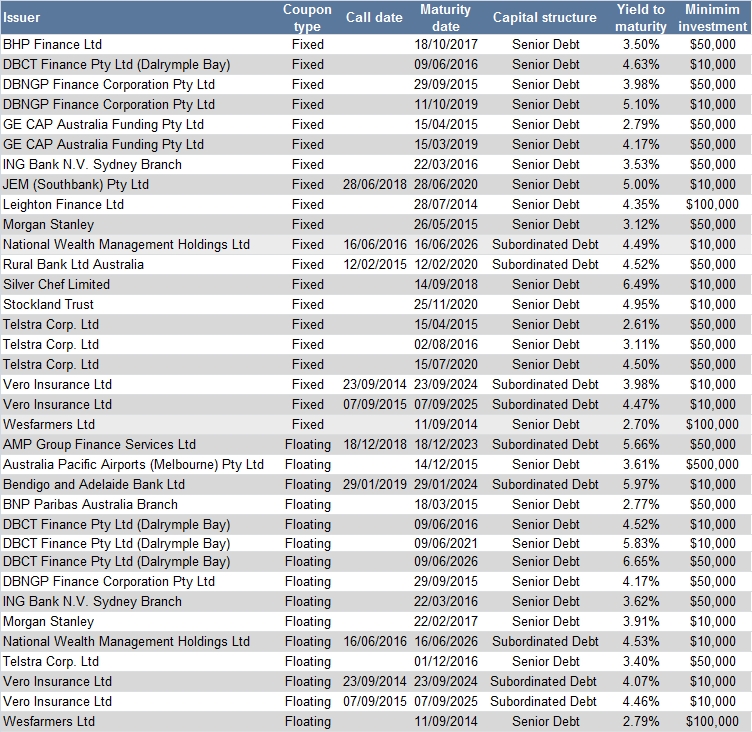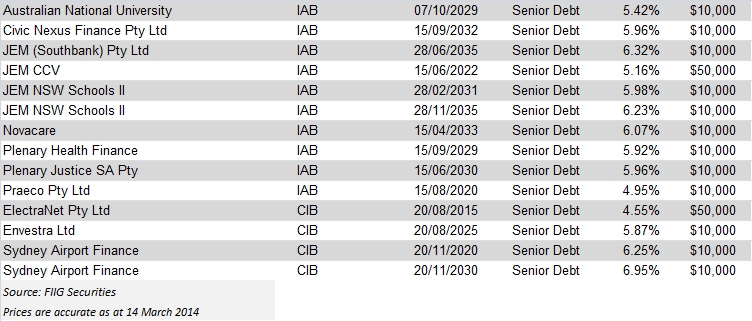by
Ekaterina Skulskaya | Mar 17, 2014
Key points:
- FIIG offers 49 retail corporate bonds through its DirectBonds service
- There are 21 fixed rate bonds, 15 floating rate notes, ten are indexed annuity bonds and four are capital indexed bonds.
- A further 50 government and semi-government are available through FIIG for retail investors.
FIIG recently added 15 new corporate bonds to its DirectBonds list, bringing the total to 250. Forty nine of those bonds are available to retail investors in smaller parcels from $10,000 (total minimum investment $50,000). There are 21 fixed rate bonds, 15 are floating rate notes, ten are indexed annuity bonds and four are capital indexed bonds.
Thirty three retail semi-government and 17 government bonds are also available to investors. Out of the total fifty, nine government and semi-government are indexed annuity bonds, while the remaining 41 are fixed rate bonds available in $10,000 parcels (total minimum investment $50,000) with maturities between 2015-2035.
All investors are presumed to be retail investors unless they can prove they are wholesale (sophisticated or professional). A retail investor is an adaptation of the term retail client defined in the Corporations Act 2001, that is, an investor who receives a financial product or financial advice is a retail investor unless sections 761G (5), (6) and (7) or section 761GA apply.
The list below details 49 retail, corporate, over-the-counter DirectBonds available. It shows the diversification possible with bonds available across industries and bond type. Forty one bonds are senior debt and nine are subordinated debt issued by Vero Insurance Ltd, Rural Bank, National Wealth Management, Bendigo and Adelaide Bank, AMP Group Finance Ltd.


Table 1
You can also choose to hold the bonds until maturity and receive the face value at that date or you can sell them prior to maturity, which may result in a higher or lower return than anticipated when you acquired the bonds.
Common terms
Call date - the date prior to maturity on which a callable bond may be redeemed by the issuer. If the issuer determines there is a benefit to refinancing the issue, the bond may be redeemed on the call date, at par, or at a small premium to par depending on the terms of the call option.
Capital indexed bonds (CIB) – CIB’s pay a predetermined coupon based on a capitalising principal amount where the capitalisation is a function of inflation. At maturity the investor receives the capitalised face value
Capital price – also referred to as “clean price” and does not include any accrued interest.
Face value - is the initial capital value of the bond and the amount repaid to the bondholder on its maturity, usually $100.
Indexed annuity bond (IAB) – an IAB is an annuity structure where each periodic payment includes a combined coupon and principal component, known as the “base payment”. The base payment is adjusted for inflation.
Maturity - this is the date when the bond is due for repayment by the issuer. The principal plus any outstanding interest of a particular security will be repaid on this date.
Running yield - uses the current price of a bond instead of its face value and represents the return an investor would expect if he or she purchased a bond and held it for a year. It is calculated by dividing the coupon by the market price.

Yield to maturity - the return an investor will receive if they buy a bond and hold the bond to maturity. It is the annualised return based on all coupon payments plus the face value or the market price if it was purchased on a secondary market. Yield to maturity thus includes any gain or loss if the security was purchased at a discount (below face value) or premium (above face value). It refers to the interest or dividends received from a security and is usually expressed annually or semi-annually as a percentage based on the investment’s cost, its current market value or its face value. Bond yields may be quoted either as an absolute rate or as a margin to the interest rate swap rate for the same maturity. It is a useful indicator of value because it allows for direct comparison between different types of securities with various maturities and credit risk. Note that the calculation makes the assumption that all coupon payments can be reinvested at the yield to maturity rate. Also, the yield and coupon are different.
If you would like to learn more about bonds, or to discuss possible strategies, please contact your local dealer.
Note: prices and yields are accurate as at 14 March 2014, and are guide only and subject to market availability. FIIG doesn’t make a market in these securities.